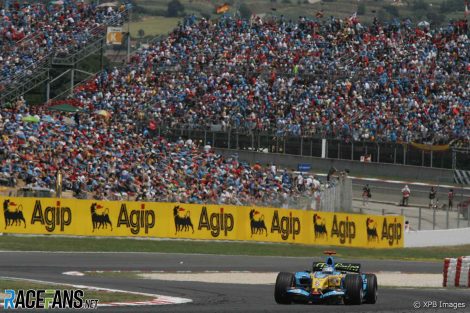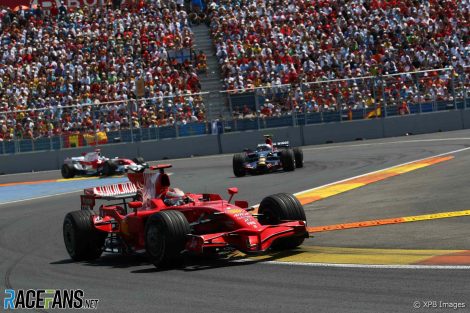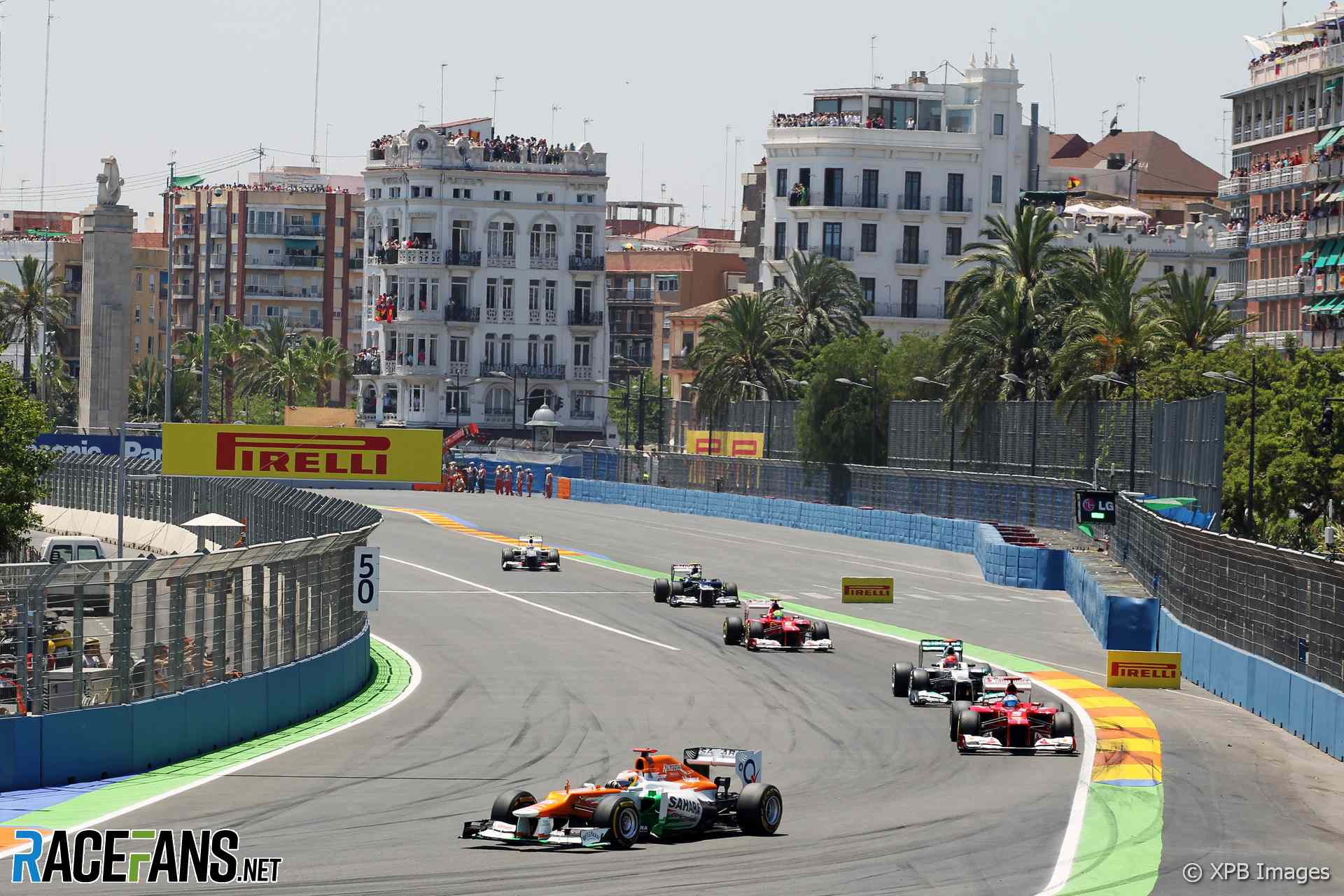The Spanish Grand Prix is one of the most enduring events on the Formula 1 calendar. It has been held 53 times and F1 has raced in the country on 60 occasions.
However its circuits, for one reason or another, have generally failed to inspire great affection.From 2026 the Spanish Grand Prix will move to a new street circuit in Madrid. It has a low bar to clear if it is to be considered an improvement over Spain’s last temporary F1 track.
Lewis Hamilton summed up the views of many when RaceFans asked him at last year’s Spanish Grand Prix what he thought of the race potentially moving to a street track in Madrid: “As long as it’s not like Valencia was, which wasn’t the most enjoyable track to drive…”
The Valencia Street Circuit, which F1 introduced to typical fanfare in 2008 but left just four years later, was a little-loved venue. It distinguished itself mainly by making Spain’s other F1 track at the time, the Circuit de Catalunya, appear considerably better by comparison.
Although F1 say they are keeping their options open, there is a serious chance Madrid’s arrival will spell the end for Catalunya as a grand prix venue. Spain has other F1-standard permanent tracks – Motorland Aragon further to the west, Jerez in the south and Valencia’s permanent Ricardo Tormo course – but F1 has opted to add another street circuit.
As always, the motivation is chiefly financial. The same reasoning brought F1, unsuccessfully, to Valencia. Will Madrid fare any better?
It will be the fourth street circuit F1 has raced on in Spain. The first, Pedralbes, held a pair of races in the fifties.
Its simple layout gives the lie to the claim F1 didn’t race on simplistic street tracks before Liberty Media came along; nor, indeed, that it didn’t perform in the service of dubious regimes before Bernie Ecclestone. The 6.3-kilometre Pedralbes track featured just five corners of note, and a straight of vast length and width named after the dictator Franco, whose regime killed – or ‘disappeared’ – hundreds of thousands.
After two races in 1951 and 1954 – won respectively by Juan Manuel Fangio in an Alfa Romeo and Mike Hawthorn in a Ferrari – F1 left Spain. It returned at Jarama, a permanent track outside Madrid, in 1968.
Jarama was one of a clutch of compact ‘aerodrome’ tracks which sprang up in the sixties and seventies. It paled in comparison to older venues and many which were to follow. Designed by John Hugenholz, who also created the stunning Suzuka in Japan during the sixties, Jarama was a far tamer affair featuring many slow corners.
Advert | Become a RaceFans supporter and
F1’s last race there in 1981 verged on the comical as Gilles Villeneuve held off a queue of faster cars in a Ferrari which handled like a truck but sprinted down the straights, rendering him immune to being overtaken.
F1 also raced at one of Spain’s most fondly-remembered venues, the Montjuic Park circuit in Barcelona, which alternated hosting the race with Jarama. This is rightly regarded as one of F1’s best street circuits, mixing a variety of corners, dauntingly quick sections and sharp changes of elevation.
However the layout proved incompatible with the sharply escalating speeds of the seventies. By 1975, safety had become a serious concern, and the driver initially went on strike until barriers were properly fixed in place.
The teams’ mechanics worked to ensure the barriers were mounted correctly. The grand prix went ahead, but tragedy struck. A rear wing support failed on Rolf Stommelen’s Hill and his car cleared a barrier, striking and killing four spectators. F1 never returned to Montjuic.
If Jarama failed to capture the imagination of fans nor did its successor, Jerez, despite the latter witnessing one of the greatest finishes to a grand prix when it debuted in 1986. Ayrton Senna beat Nigel Mansell to the line by a mere 14 thousandths of a second in a classic tussle.
The pair reprised their scrap when F1 moved on to its next Spanish venue, the Circuit de Catalunya, in 1991. This venue proved Spain’s most enduring F1 host by far, and for years was also the team’s testing venue of preference, by virtue of its location, climate and configuration.
Advert | Become a RaceFans supporter and
Catalunya’s mid-to-high speed corners show F1 cars at their best the way few other venues do. However it consistently failed to produce lively races, due in no small part to an awkward chicane inserted on safety grounds in 2007, and finally bypassed last year.

They had to wait: Alonso finished runner-up to Michael Schumacher in 2003 and Kimi Raikkonen in 2005 before finally delivering the home victory they craved in 2006 as reigning world champion. Alonso’s last grand prix victory to date came at the track in 2013.
In some respects Catalunya’s problem was over-familiarity. During the years on unlimited testing F1 cars pounded the track seemingly without end.
But if that venue underwhelmed, Spain’s last street circuit deserves to be regarded as by far its least impressive F1 venue. Valencia’s street track was a soulless collection of sharp corners and straights bordered by walls, enlivened only by a brief sequence of quick bends before the final corner.
It produced four largely unmemorable races (Mark Webber’s 2010 acrobatics aside) then a lively 2012 encounter which Alonso astonishingly won from 11th on the grid. Proof that even the most uninspiring track can produce a good race if the stars align.
Advert | Become a RaceFans supporter and

Instead Madrid has a 10-year deal. It will follow the likes of Miami and Las Vegas in being chosen by Liberty Media as one of the ‘destination cities’ it wants to populate the calendar with.
It remains to be seen whether the crowd will have both twice world champion Alonso and race winner (not to mention Madrilenian) Carlos Sainz Jnr to cheer on come 2026. But at the very least Spain’s latest street circuit must banish the memories of its last one.
Formula 1
- “You need to be more on it”: 12 unheard radio exchanges from the Chinese GP
- F1 CEO Domenicali wants more than six sprint races per year
- Hulkenberg named Audi’s first F1 driver for 2026
- Ricciardo needs to show “head-turning form” for 2025 chance – Horner
- F1 Commission defers decision on points change and approves new rear cameras





MacLeod (@macleod)
23rd January 2024, 13:21
meeeuh……..hitting head on table several times…..
johnt1788 (@johnt1788)
23rd January 2024, 13:22
Another IKEA-flat pack street circuit around roads with no racing tradition?
I highly doubt it.
Yaru (@yaru)
23rd January 2024, 14:13
Traditions have to start somewhere.
uzsjgb (@uzsjgb)
23rd January 2024, 16:56
Anything to get rid of the tradition of racing at boring Barcelona.
Craig
23rd January 2024, 14:20
I never had a real problem with Barcelona, it was a great litmus test to see who did have a good or bad car as the opening rounds tend not to paint a true or consistent picture (being either night or street circuits). Suzuka may take that place this year but I think we’ll very quickly miss Barcelona.
mc4ren (@mc4ren)
23rd January 2024, 16:09
A clear backwards step. As others have said, a dull track, in a zero attractiveness environment. Just compare it to Jarama and its elevation changes… it’s sad to see that quality of racing has been the last selection parameter. Not to say that Barcelona is a great track for overtaking, but at least it’s a real track. Street circuits, where the safety walls hide so much, are so boring. If you add a flat track, then it’s totally a forgettable experience. I go to Barcelona every year, but this change to Madrid has left me unimpressed, I’m so disappointed with the route Formula One is taking. I’m getting closer to the point of finding an alternative racing series that keeps some purity and essence.
MichaelN
23rd January 2024, 16:20
It’s a worrying sign indeed that some now hail the once reviled Barcelona track as one of the better ones on the calendar.
It has had plenty of time to show what it’s all about – and it’s no big loss to give another place a go.
Whether Madrid will be able to escape the dull concrete and fence-covered template of other such new “street” tracks remains to be seen, though. Hopefully they don’t get the silly idea to have it be a night race…
uzsjgb (@uzsjgb)
23rd January 2024, 16:58
Not worrying at all. There will always be “some”, who have strange opinions. Ignore them.
ferrox glideh (@ferrox-glideh)
23rd January 2024, 18:15
Everyone has strange opinions.
ferrox glideh (@ferrox-glideh)
23rd January 2024, 18:13
I always really liked the first four corners of Catalunya, and turn nine is a genuine test of driver skill. I am sure that the powers that be have learned from the Valencia debacle, so I am optimistic that this new venue will be an interesting addition. If Alonso is still racing in 2026 (why not?), it will be a successful event. What I would really like to see is F1 return to race in Portimão, Portugal.
ferrox glideh (@ferrox-glideh)
23rd January 2024, 18:25
The 1973 clip is worth watching just to see Colin Chapman celebrate at the checkered flag… on the bloody track!
Another great article KC.
Asd
23rd January 2024, 18:33
Everything would be better than Catalunya.
I have no idea how the owners of the track never decided to change the layout of the track other than inserting a dumb chicane.
Phil Norman (@phil-f1-21)
23rd January 2024, 20:04
Well Barcelona has been on life support for many years and there has been recurring talk of the race dropping off the calendar. It does tend to produce quite boring races, although I seem to recall last years was better than average. I don’t think it will survive as well as Madrid and I doubt it will be much missed.
I am therefore willing to give Madrid a chance, even though F1 really does not need any more street circuits. I do hope this is the last one.
Paul2013
24th January 2024, 0:29
Jarama was by far the BEST circuit.
But It was a private one and, as many other, old, small and beautiful (private) circuits in Europe almost disappear Because they could not invest the Big amount of money F1 and MotoGP required.
So now all these circuits in the UK, Holland, Spain, Italy… just have “low level” races like trucks, national competitions, amateurs….
All that just Because F1 wanted more and more money.